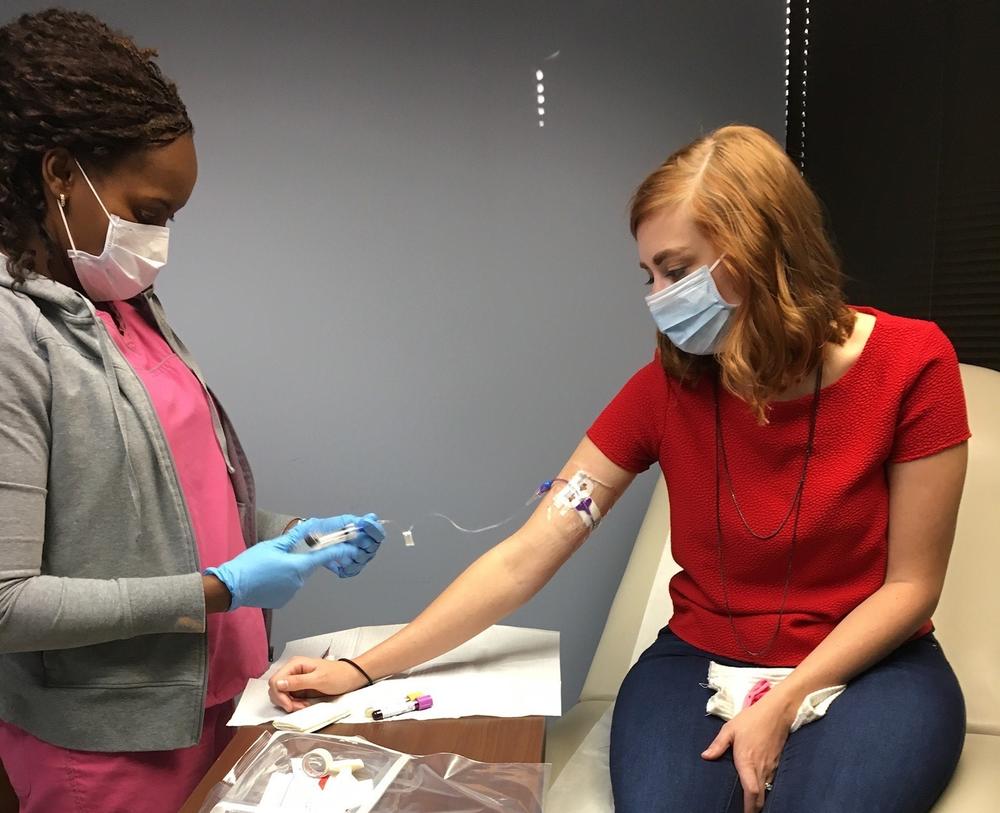
Caption
Rachel Draddy receives treatment for Lyme disease. Now in her early 30s, Draddy contracted the tick-borne disease while in high school.
Credit: Contributed
LISTEN: A pharmaceutical company is developing a vaccine to prevent Lyme disease, an illness spread by ticks. GPB’s Ellen Eldridge has more.

Rachel Draddy receives treatment for Lyme disease. Now in her early 30s, Draddy contracted the tick-borne disease while in high school.
Rachel Draddy was a freshman in high school and living in the metro Atlanta area when she started feeling symptoms of dizziness, nausea and fatigue.
Slowly, over time, more and more symptoms developed and she was unable to get any answers, she said. Part of that reason was because Draddy didn't realize what was happening.
"I was a dancer all through high school and even some in college, and so I was kind of used to like having muscle pain," she said. "And I think I just didn't realize the amount of pain I was in was unusual."
But by her sophomore year of college, Draddy said the muscle pain in her legs was so bad she couldn't walk across campus. She ended up dropping out of college.
Draddy didn't get a Lyme disease diagnosis until she was almost 20, and by that time the disease had progressed through her body and into her brain.
"In order to get enough a high enough medication dose to get into your brain, you really had to take a lot," Draddy said. "The issue was every time we would try and kind of increase to the amount that I needed to be on, I would end up throwing up and being super sick."
Though she is well recovered now at age 31, Lyme is a constant concern.

Rachel Draddy treats her Lyme disease.
"Every time I wake up a little sore, you know, every time I have a headache, it sort of runs in the back of your head, 'is this coming back?'" she said. "And the issue is because the testing is so sketchy, there really isn't a way for anyone to tell me it's 100% gone. And so that's pretty intimidating."
Draddy said she is constantly checking in with her body, which is a good thing to do. But she said it's also exhausting.
"You kind of tend to overanalyze every little ache and pain, every weird moment; you are reading way too much into it," she said.
With rising atmospheric temperatures, Lyme disease, an illness spread by ticks, continues to increase across the country, affecting mainly children under 15 and older adults.
The Centers for Disease Control and Prevention currently recognizes 18 tick-borne diseases in the United States, many of them newly emerging. Lyme is one of the most well-known tick-borne illnesses and has in recent decades grown into the most common vector-borne disease in the country.
“Ticks are everywhere in Georgia,” Gonzalo Vazquez-Prokopec, associate professor in Emory’s Department of Environmental Sciences said.
He’s senior author of an Emory study on the tick-borne Heartland virus in Georgia that was published in the journal Emerging Infectious Diseases. The novel virus was first discovered in 2009 in northwestern Missouri after two local men were hospitalized with high fevers, diarrhea, muscle pains, low counts of white blood cells and platelets, and other symptoms similar to known tick-borne diseases, like Lyme.
Vazquez-Prokopec's research focused on ticks collected in the central part of Georgia.
While not common in Georgia, the disease can make people very sick. That's why Moderna announced in April its hope of preventing Lyme using mRNA technology, which was first widely used in the vaccine to prevent COVID-19. This is the company's first application of its mRNA technology to bacterial pathogens.
Pfizer Inc. is also investigating a Lyme disease vaccine candidate, VLA15, which the company says is the only vaccine candidate currently in clinical development.